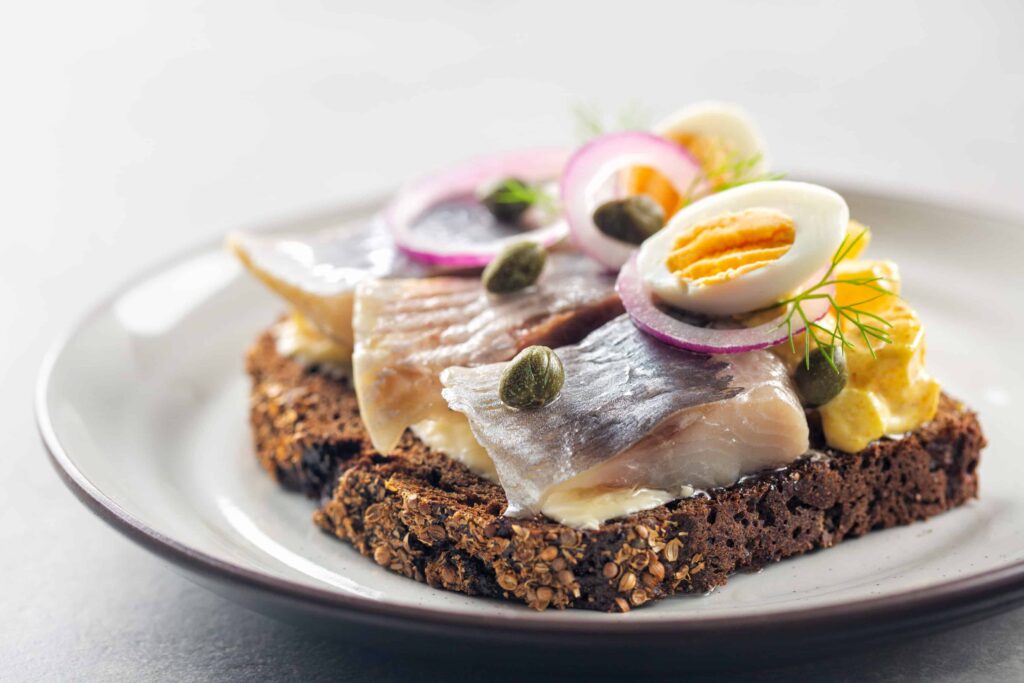
Smorrebrod, a national dish of Denmark, is more than just an open-faced sandwich. It’s a culinary art form, steeped in tradition and cultural significance. This Danish delicacy has evolved over centuries, reflecting the country’s history and changing tastes.
Our team at Remitly created this guide as part of our series that celebrates the traditional foods of our global customers. Lear more about Smorrebrod and learn how to make your own with this guide.
The Origin of Smorrebrod
Smorrebrod traces its roots back to the Middle Ages when thick slices of bread served as plates for meals. Over time, these bread plates became part of the meal itself. The term “smorrebrod” translates to “butter and bread,” indicating its humble beginnings.
However, it wasn’t until the 19th century that smorrebrod took on its modern form. As industrialization swept through Denmark, workers needed hearty lunches they could eat quickly or take with them to work. Thus, smorrebrod evolved into a convenient yet satisfying meal option.
Traditional Ingredients in Smorrebrod
At its core, smorrebrod consists of a slice of rye bread topped with butter and various ingredients. The toppings can range from cold cuts and fish to cheese and vegetables—each one carefully chosen and arranged for maximum flavor impact.
Fish is often used in traditional smorrebrod recipes—herring being a popular choice due to Denmark’s coastal location. Meat toppings typically include liver pate or roast beef while fresh dill, horseradish cream or pickled gherkins add an extra layer of complexity to the taste profile.
A Simple 5-Step Recipe of Smorrebrod
Ingredients:
- 4 slices of dense rye bread
- Butter, as needed
- 8 pieces of pickled herring
- 1 red onion, thinly sliced
- Fresh dill sprigs, for garnish
Instructions:
- Start by spreading a generous layer of butter on each slice of rye bread.
- Arrange two pieces of pickled herring on each slice.
- Top the herring with thin slices of red onion.
- Garnish with fresh dill sprigs.
- Serve immediately or refrigerate until ready to eat.
Remember, this is just one version of smorrebrod—you can experiment with different toppings based on your preferences.
Variations of Smorrebrod Across Denmark
While there are some common elements in all smorrebrods—rye bread base, butter spread—the variations across Denmark are vast. Each region has its own unique twist on this classic dish.
In Copenhagen for instance, you’ll find gourmet versions featuring luxury ingredients like caviar or smoked salmon. Meanwhile in Jutland—the rural heartland—smorrebrods tend to be simpler, often featuring locally sourced ingredients such as pickled herring or homemade liver pate.
Etiquette and Customs Around Eating Smorrebrod
Eating smorrebrod also involves certain customs. It’s typically eaten with a knife and fork, not by hand—a nod to its origins as a plated meal. And it’s usually enjoyed with beer and snaps—a type of Danish spirit—to complement its hearty flavors.
There’s also an order to eating different types of smorrebrods: fish-based ones are eaten first, followed by meat-based ones, and finally cheese-based ones. This sequence allows for a gradual build-up in flavor intensity.
Influence of Smorrebrod on Danish Cuisine
Smorrebrod holds a significant place in Danish cuisine. Its emphasis on quality ingredients reflects Denmark’s culinary philosophy—simple yet flavorful food that respects nature’s bounty.
Moreover, smorrebrod has influenced modern Danish gastronomy too. Renowned chefs have reimagined this classic dish in innovative ways—using new techniques or exotic ingredients—while still honoring its traditional essence.
Broader Cuisine of Denmark
Danish cuisine is characterized by its simplicity, quality ingredients and hearty flavors—traits reflected in smorrebrod.
Traditional Danish Dishes
Apart from smorrebrod, other traditional dishes include frikadeller (Danish meatballs), stegt flæsk (fried pork belly) and grønlangkål (curly kale stew). These dishes are often enjoyed during family gatherings or festive occasions.
Seafood also plays an important role in Danish cuisine due to the country’s extensive coastline. Fish such as cod, plaice and salmon are commonly used in various recipes—from soups and stews to smoked fish preparations.
Baking Traditions
Baking is another integral part of Danish culinary culture—with pastries like wienerbrød (Danish pastry) and rugbrød (rye bread) being household staples. The Danes also have a tradition called “hygge”—a concept that involves creating a warm, cozy atmosphere and enjoying the good things in life with loved ones—which often includes indulging in baked goods.
Modern Danish Cuisine
In recent years, Denmark has gained international recognition for its innovative culinary scene. Copenhagen, the capital city, is home to several Michelin-starred restaurants that are pushing the boundaries of traditional Danish cuisine—incorporating new techniques and global influences while still honoring local ingredients and traditions.
Despite these modern developments, the essence of Danish cuisine remains rooted in simplicity and respect for quality ingredients—a philosophy that continues to guide both home cooks and professional chefs alike.
Visit the homepage, download our app, or check out our Help Center to get started.
